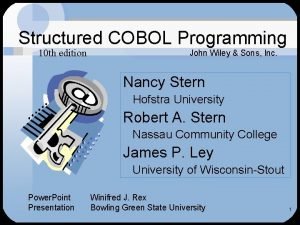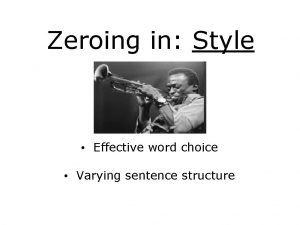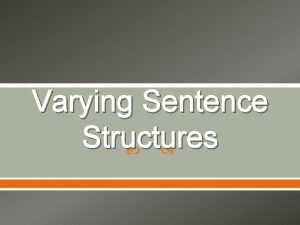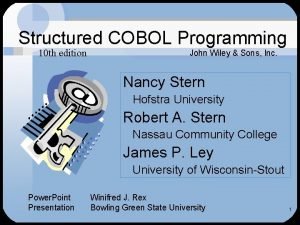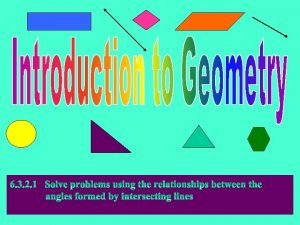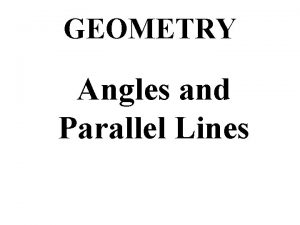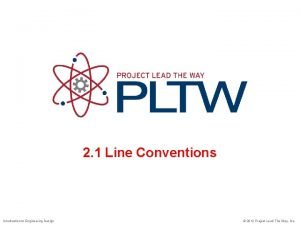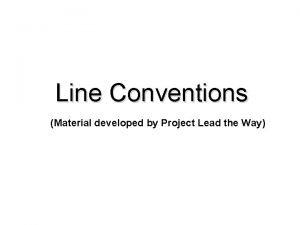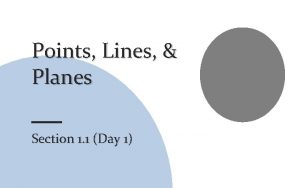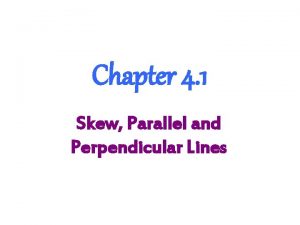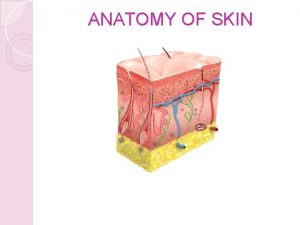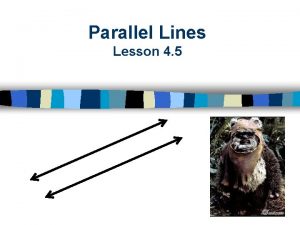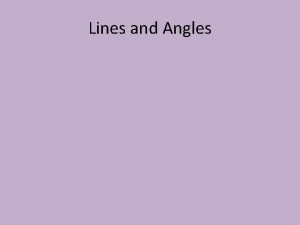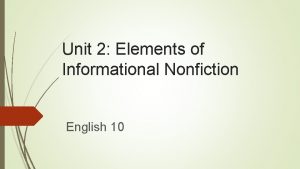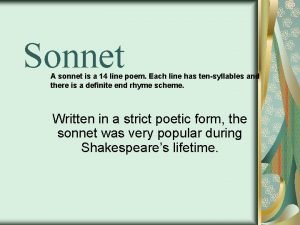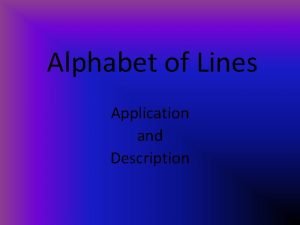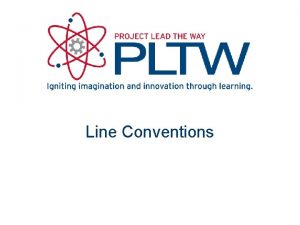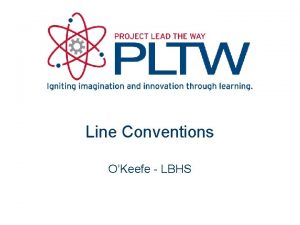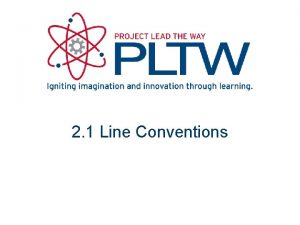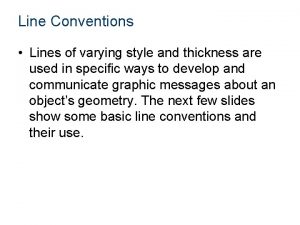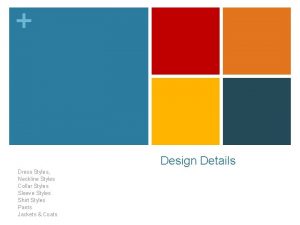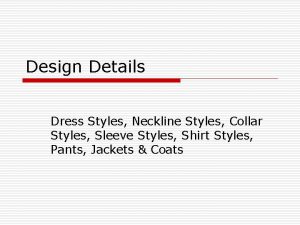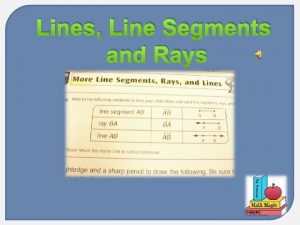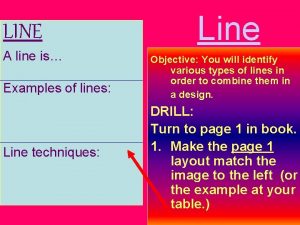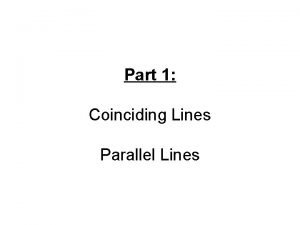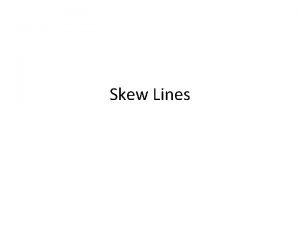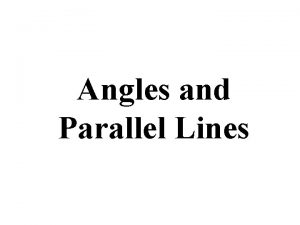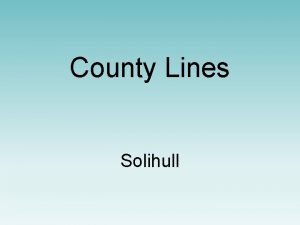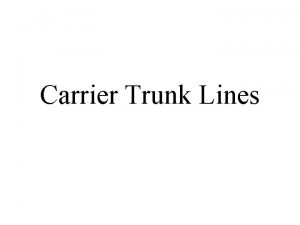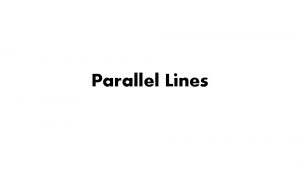Line Conventions Line Conventions Lines of varying styles




























- Slides: 28


Line Conventions

Line Conventions Lines of varying styles and line weights are used in specific ways to develop and communicate graphic messages about an object’s geometry. The next few slides show some basic line conventions and their use. Line Weight – the thickness (darkness) of line

Line Conventions Construction Line: Very lightly drawn lines used as guides to help draw all other lines and shapes properly. Construction Lines

Line Conventions Object Lines: Lines are thick and dark; used to define the object Object Line

Stop here

Line Conventions Hidden Line: Lines used to show interior detail that is not visible from the current outside view of the part. • medium weight lines Hidden Lines

Hidden Lines

Stop Here

Line Conventions Centerline and Center Marks: Center Lines that define the center of arcs, circles, or Symmetrical parts. They are half as thick as an object line. • Light weight lines Center Mark

Center Lines

Center lines


Line Conventions • Dimension Lines: Lines that are used to show distance. • Arrows are drawn on the ends to show where the dimension line starts and ends. • The actual distance is usually located in the middle of the line to let you know the distance being communicated. • Light weight lines Dimension Line

Line Conventions • Extension Lines: Lines used to show where a dimension starts and stops on an object. • Used with dimension lines to properly dimension an object. • The line is 1/16” away from the part as to not get confused with the Extension object lines. Line • Light lines Extension Line

Line Conventions • Leader Lines: Line used to • • • connect a feature of a drawing to some information about that feature. The leader line might point to a feature that is a point, a line, a surface, a circle, arc, or even the whole part On the other end of the leader line there will be information regarding the dimension, a note or an item number. A leader line says, “Look here and Leader read this!!!” Line Don’t want to write the information in the drawing so use a leader line. Light lines Leader Line Sand surface 4

Object Lines Construction Lines Very Light Leader Lines

STOP HERE FOR THE CHAPTER

Line Conventions Section Lines: Section Lines are used to define where there is material after a part of the object is cut away. Section Line

Line Conventions Short-Break Line: A freehand drawn line that shows where a part is broken to reveal detail behind the part or to shorten a long continuous part. Short-Break Line

Line Conventions • Long-Break Lines: Used to shorten very long objects that do not change in detail. • The line is usually represented as a jagged cut or break. Long-Break Line

Line Conventions • Cutting Plane Line: is the plane that cuts through a component to create a sectional view showing the internal details that cannot be seen from the outside Cutting Plane Line

Object Lines Construction Lines Light Leader Lines

Line Conventions Though these standards relate to technical drawing, which is far more precise than freehand sketching, their conventions should be used as a guide when sketching.

Precedence of Lines When sketching complex objects, different line types will often overlap each other. Therefore, line precedence must be exercised.

Precedence of Lines The following are rules that govern line precedence in sketches and technical drawings. • Object lines take precedence over hidden and center lines. • Hidden lines take precedence over center lines. • Cutting plane lines take precedence over all others.

Precedence of Lines Object lines take precedence over the hidden lines. An object line here takes precedence over the center line.

Precedence of Lines • Object lines take precedence over the center lines you would see from the hole. • Object lines take precedence over the hidden lines you would see from the slot cut out in top view. An object line here takes precedence over the hidden line. An object line here takes precedence over the center line.
 Conventional lines
Conventional lines Exit sentence
Exit sentence Varying sentence structure
Varying sentence structure Stokes's theorem
Stokes's theorem Assumptive adverb opener examples
Assumptive adverb opener examples Equation of continuity for time varying fields
Equation of continuity for time varying fields Interesting sentence openers
Interesting sentence openers Cobol perform varying decrement
Cobol perform varying decrement Work done by a varying force
Work done by a varying force Varying sentence beginnings
Varying sentence beginnings Balanced sentence examples
Balanced sentence examples Cobol search varying
Cobol search varying Line vw and line xy are parallel lines drawing
Line vw and line xy are parallel lines drawing Intersecting lines angles
Intersecting lines angles 66454 subject code
66454 subject code What are line conventions
What are line conventions Lightly drawn lines to guide drawing other lines and shapes
Lightly drawn lines to guide drawing other lines and shapes Line conventions
Line conventions Line conventions definition
Line conventions definition Worksheet 1-1 points lines and planes
Worksheet 1-1 points lines and planes What is a skew line
What is a skew line Kraissl lines vs langer lines
Kraissl lines vs langer lines Lines are lines that never touch and are coplanar.
Lines are lines that never touch and are coplanar. Orthagonals
Orthagonals Vertical angles
Vertical angles How did the passage
How did the passage A poem consisting of 14 lines with 10 syllables per line
A poem consisting of 14 lines with 10 syllables per line Alphabet lines drawing
Alphabet lines drawing Analytical intuitive functional and personal
Analytical intuitive functional and personal







